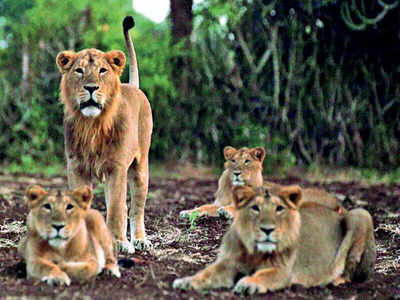 |
| A pride of Asiatic lions |
 |
| View of Gir Forest, the last stronghold of the Asiatic lion. |
I'm really amazed that there is a new conservation program in the making after Project Tiger and Project Elephant. It goes to show how India is very serious about the conservation of its wildlife. The Asiatic lion has for decades been protected in Gujarat's Gir Forest National Park and during the time, its numbers grew exponentially resulting in lions dispersing beyond the borders of the national park and into parts of Gujarat where they had long disappeared. But despite the increase in numbers, India's lions faced numerous challenges outside Gir Forest in the form of man-made obstacles (i.e. wells) and diseases. Disease in the form canine distemper took a life-threatening toll on the lions, killing 25 animals almost two years ago. The situation prompted the need to trans-locate lions outside Gujarat. Now, it looks like there is a glimmer of hope for lions as conservation efforts along the lines of Project Tiger will be implemented to ensure that they are fully protected from anthropogenic threats and diseases.
 |
| Map of proposed trans-location sites for lions (light blue). Note: Chandraprabha (pink) was a former site of trans-location. |
What struck me about this news is that the implementation of Project Lion could probably mean Gujarat would lose its "monopoly" for lion sightings. I would like to point out that historically the lion's range included central, northern, and western India, including Gujarat. But because of decades of habitat destruction and hunting, India's lion population became reduced to Gujarat where the animal has since remained and became a special icon to the local people. I strongly believe that the lion's home range should never be restricted to just Gujarat; it is highly crucial that it should be reintroduced in parts of India where it had long disappeared. Any disputes over the trans-location of lions out of Gujarat should be done strictly on scientific and not political grounds. I would suggest that some number of lions should be trans-located in a chosen protected area such as Kuno Palpur, and then closely monitored to see how well they are adapting in their new environment. I would also suggest that captive breeding programs should be created as part of this new project. This would help in trans-location efforts when newly released wild lions from Gujarat somehow fail to adapt outside the state. The purpose of captive-breeding programs should not just focus on breeding lions in captivity. It should also focus on providing them with behavioral enrichment to stimulate their instincts essential for survival in the wild before releasing them into the wild. Furthermore, areas both inside and outside Gujarat should be identified as protected areas for lions by checking for any indirect evidence of the big cats, abundance of prey, and make sure they are free of any anthropogenic pressure. I have a pretty good feeling that Project Lion will benefit the Asiatic lion and I hope the people involved in the program will carry it out concertedly in order to ensure the survival and well-being of the lion on the long-run.
No comments:
Post a Comment